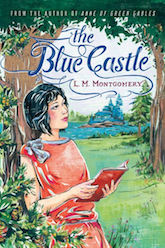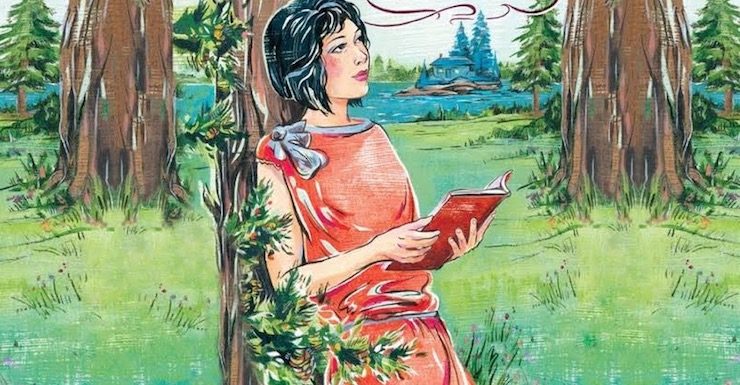I’m cheating, just a little bit, with this next entry. The Blue Castle (1926), by L.M. Montgomery, is not, strictly speaking, a fairy tale. Firmly set in the very real world of Muskoka, Ontario, it does not have a single fairy, or monster, or even a flicker of a ghost. But from time to time, its characters do seem to think that they might be in a fairy tale—even though, as it turns out, the one they think they are in is not the one that they might be in. So I’m counting it.
Oh, and the fairy tale the characters laughingly say that they might be in? Bluebeard. The fairy tale they really might be in? Sleeping Beauty—or perhaps Rapunzel. With a touch of Cinderella.
L.M. Montgomery then and now was best known for her classic work about a cheerful red-headed orphan, Anne of Green Gables (1908). As the 1920s marched on, this depressed her: Anne of Green Gables had received considerable critical acclaim, but she had ended up in a nasty, ongoing lawsuit with her publisher that drained her emotionally and financially, and she was finding herself relegated to the ranks of sentimental children’s authors—a categorization that humiliated and upset her.
 Married to a minister, who by then was already suffering from a combination of attacks of severe mental illness, and, Montgomery’s biographer Mary Rubio argues, unintentional poisoning from the drugs he took to treat those attacks, Montgomery was constrained in just what she could write that would not deeply offend her husband’s congregation. Nonetheless, she decided to fight back by releasing a work that was, in her mind, most definitely not written for children, a novel that included an alcoholic, an unwed mother, a scene of threatened rape, and other elements definitely not associated with children’s literature at the time—or appropriate subjects for a minister’s wife.
Married to a minister, who by then was already suffering from a combination of attacks of severe mental illness, and, Montgomery’s biographer Mary Rubio argues, unintentional poisoning from the drugs he took to treat those attacks, Montgomery was constrained in just what she could write that would not deeply offend her husband’s congregation. Nonetheless, she decided to fight back by releasing a work that was, in her mind, most definitely not written for children, a novel that included an alcoholic, an unwed mother, a scene of threatened rape, and other elements definitely not associated with children’s literature at the time—or appropriate subjects for a minister’s wife.
The Blue Castle is the story of Valancy, who lives a life that makes the word “repressed” sound positively liberated. In her late 20s, she lives with her mother and her aunt in a life of relentless sameness and repression, unable even to read novels, choose the decorations for her own room, purchase her own clothing or attend a church of her choosing. Part of this stems from her family, who as individuals and en masse shredded her self-confidence, but part of this is also her society: a society that sees only one fate for women, marriage. And Valancy does not have the money or education or self-confidence to escape this.
This was a reality that Montgomery knew well from her own experience—apart from the self-confidence part. Well aware that she would inherit little or nothing from her own extended family and financially shiftless father, Montgomery realized early on that she had very few financial options other than marriage. Her extended family paid for full educations (and the occasional trip to Europe) for sons, but not for the ambitious Montgomery, who paid for her one year at college by saving up money by staying in terrible boarding houses while teaching and with a small sum from her grandmother, who apparently wanted to help equip her then-unmarried granddaughter for later life.
That extra education paid off: Montgomery was able to obtain a temporary position as a proofreader for a city newspaper, and earned a respectable income from short stories and novels. She later paid for the advanced education of another ambitious cousin and close friend Fredericka MacFarlane, allowing that cousin to pursue a career. But she remained acutely aware of the limited options for women, something she explored extensively in her short fiction, even as she allowed Anne Shirley to go to a four year college.
This lack of options is also something she explores in The Blue Castle. When Valancy does finally decide to try to live more independently, after a medical diagnosis informing her that she has only a year to live, that “more independently” initially means only sliding down a bannister and feeling free to tell her extended family exactly what she thinks of them, in the book’s sharpest, most hilarious scene. Travel isn’t an option—she has very little money—and work isn’t either: apart from the health issue, she has limited education and few job skills.
When Valancy hears that an acquaintance is dying of tuberculosis, she finally leaves home as a combined housekeeper/cook/general maid/companion. That acquaintance, Cecily “Cissy” Gay, is another example of the restrictions placed on women: she became pregnant out of wedlock because she “didn’t know some things.” This in turn makes her a pariah of the community, leaving Valancy as one of the few women in the community willing to help—over the objections of her relatives, concerned that helping Cissy will tarnish Valancy’s reputation.
Here, Valancy is able to be useful—and finally does receive praise for one skill, cooking. And here, she meets her Prince Charming—the sloppily dressed man with a mysterious past, Barney Snaith, who owns an island out in a lake. Still desperate to live her last year, she asks him to marry her. To their somewhat mutual surprise, he agrees.
In a neat reversal of Sleeping Beauty, their kiss marks Valancy’s transition from the mundane world of her home and its surroundings—complete with very un-fairytale gossip, alcoholism and unwed mother—to a world of enchantment: Barney’s beautiful, isolated island, where, as Montgomery notes, “Valancy toiled not, nor did she spin.” She cooks, she dreams, she reads, she takes long walks in the woods with Barney. Valancy names their cabin, only half-jokingly, her Blue Castle—after the castle she created in her imagination.
And like any good fairy tale castle, it has secrets: Barney’s mysterious past, and a door which Valancy is not allowed to open, to a room that both she and Barney term “Bluebeard’s Chamber.”
The name is just one of many allusions and mirrors of fairy tales. Like Cinderella, Valancy transforms from a downtrodden creature to a beauty—partly through housework, partly through attending a dance, which transforms rather sharply at midnight. A pivotal moment in the plot even includes a shoe. Like Beauty in Beauty and the Beast, Valancy leaves her enchanted palace from time to time—to visit family, to see the occasional movie and sample Chinese food, or do some necessary shopping—but unlike Beauty, she returns to her enchanted island more than promptly, preferring it to the real world, sobbing at the thought of leaving it. Like Rapunzel, she is initially kept isolated by the machinations of an older woman.
But above all, this is the story of a woman trapped not by a spell, but by society and fear, who is rescued by a series of errors and a kiss. Come to think of it, it probably is a fairy tale after all.
Mari Ness lives in central Florida.










